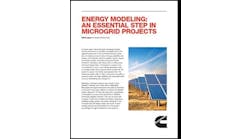Asking All the Questions You Can Ask about a Microgrid via Georgia Tech Project
A partnership between the Georgia Institute of Technology and Georgia Power, a Southern Company utility, aims to study “all the questions you can ask about a microgrid” through the 1.4-MW Tech Square Microgrid, a behind-the-meter demonstration project in midtown Atlanta on the Georgia Tech campus.
Owned by Georgia Power, the Tech Square Microgrid began operating in June and will serve Georgia Tech’s Coda building, which includes research labs and a high-performance computing center. The capital cost is $4.8 million. As approved in a 2019 rate case, Docket 42516, that amount will be recovered through rates over the life of the microgrid, said Tom Krause, a spokesman for the Georgia Public Service Commission (PSC).
The microgrid is comprised of Tier 4 diesel fuel — which meets the strictest Environmental Protection Agency emissions for off-highway diesel engines — plus natural gas, a fuel cell and battery storage. It’s also designed to be expanded to include additional sources of power, possibly solar, said Jim Smith, chief operating officer at PowerSecure, which installed the microgrid.
“This real-time learning lab in the heart of Atlanta will look at all the questions you can ask about a microgrid,” Smith said. “How does a research university work together with Georgia Power? We’ll be learning so much on the behind-the-meter load side, but also how the microgrid works with the distribution system of the utility.”
In materials filed with the Georgia PSC, Georgia Power said the demonstration project aims to develop tools to evaluate the impacts of the microgrid on the utility distribution system and evaluate grid performance when a microgrid is operating. The project will also test technologies that can offer demand management through numerous resources, including smart appliances, electric vehicles and real-time building energy management systems.
Deep dive into microgrids
The microgrid acts as a university educational tool, too. The utility sees it as a way to leverage Georgia Tech’s knowledge and experience, create a classroom for microgrid study, and provide a public “knowledge center” about distributed energy resources (DERs).
From PowerSecure’s point of view, the project offers an opportunity to dive deep into the advanced analytics and optimization of the sophisticated microgrid. When, for example, does it make sense to use the microgrid’s different resources — as opposed to taking power from Georgia Power? And the demonstration also will study whether 2-hour batteries are more expensive than 1-hour batteries, as well as the advantages of the microgrid providing grid services to Georgia Power, said Smith.
The project was approved by the Georgia PSC in 2016, Docket 40161, an integrated resource plan.
Multiple points of interconnection
Georgia Power, in its material filed with the Georgia PSC, said the project aims to demonstrate an urban setting microgrid connected to Georgia Power’s high-density distribution underground network, overhead feeder distribution system and to designated building loads in the Coda building. The microgrid, the company said, was designed to incorporate numerous DERs, including a 225-kW Samsung energy storage system, a 200-kW Bloom fuel cell and a 1,025-kW PowerSecure PowerBlock, which includes a 625-kW diesel generator and two 200-kW natural gas generators.
“The multiple points of interconnection will provide a unique opportunity to test the microgrid’s ability to interact with customer electrical loads while also supporting the distribution system,” Georgia Power said in the document, adding that this will help educate the utility about using distributed energy resources.
The utility’s goals are to study the microgrid’s impact on its system’s stability, reliability and resiliency. In addition, the project will test “end-to-end integration with the Coda building’s electrical load and evaluate the performance of distributed energy resources (DER) and microgrid technology to support the grid and the company’s customers,” said Georgia Power.
Because of the lack of space in downtown Atlanta, Georgia Tech had to build an aboveground platform to house the microgrid next to the Coda building, said Smith. Some of the equipment that’s usually located underground was placed in that building.
Smooth islanding for data center
Jim Smith, CEO PowerSecure
One of the most important aims of the Tech Square Microgrid is to provide resiliency for the Coda building, said Smith. The battery storage will play an important role in ensuring that the Coda center can seamlessly island from Georgia Power and avoid any blips in service to the data center. In a more simplistic system, when the utility power shuts down, there’s a lapse between the time the power shuts down and when the microgrid’s natural gas or diesel generation sources kick in, said Smith.
“That’s the big thing with batteries; they can provide that ride through if there’s a momentary blip in the system,” he said.
In addition to studying how the microgrid islands, the project will look at the peaking conditions of midtown Atlanta. The microgrid can be used to ease constraints for Georgia Power, providing capacity resources, peak shaving and frequency response, said Smith.
Additionally, the micorgrid will serve as a living laboratory for Georgia Tech professors and students to gather data on controllers, cybersecurity devices and energy economics.
Perhaps one of the biggest benefits of the project is that it brings together a utility, a research institution and PowerSecure to research microgrid design, analytics and optimization, said Smith.
“This is a great way for all three organizations to come together and learn how to operate microgrids in the future,” he said.
Track news cutting edge microgrids like the Tech Square Microgrid. Subscribe to the free Microgrid Knowledge Newsletter.








